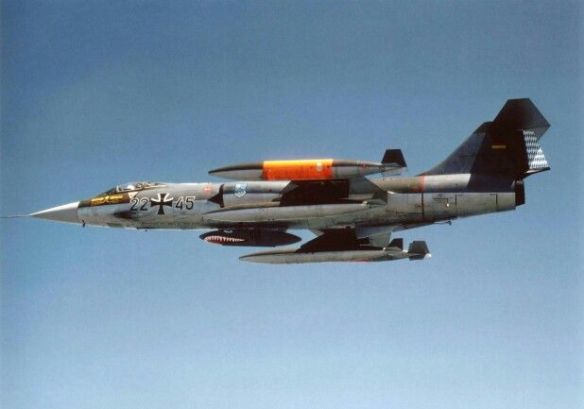In 1945, the victorious Allies dismantled and banned Germany’s ability to produce civil and military aircraft as well as other implements of war, presumably for all time. By 1955, however, the Cold War had ushered in a radical change. Two separate German states now existed, and each had been drawn into the orbits of the two remaining superpowers: the Soviet Union and the United States. The Federal Republic of Germany (West Germany) voluntarily joined NATO; the German Democratic Republic (communist East Germany) entered the Warsaw Pact.
In West Germany, the establishment of armed forces meant the resumption of aircraft production. Initially (and for many years thereafter), the resurrected Luftwaffe operated primarily U. S. aircraft. These included the Republic F-84F Thunderstreak fighter-bomber, the Luftwaffe’s first jet. Following closely were North American F-86K Sabres and, in the 1960s, Lockheed F-104G Starfighters and Mc- Donnell F-4s and later F-4Fs.
From the beginning, however, indigenous production also contributed to the Luftwaffe’s strength. Given sharply rising costs of development, many of the domestically produced aircraft came from international consortia involving German firms. For example, German-French programs produced the Nord Noratlas in the 1950s and, a bit later, the Nord-MBB C-160 Transall (in 2000 only on the verge of replacement). These hard-working twin-engine transports supplied airlift for infantry, paratroops, and cargo. A complementary German-Italian program produced the nimble Aeritalia (FIAT) G91 ground attack/reconnaissance jet, which resembled a scaled-down version of the F-86K.
Another program involving the veteran German manufacturer Dornier and the French company Dassault resulted in the Alpha Jet. This nimble trainer/ground attack fighter did yeoman’s service in the Luftwaffe. In more recent years, a European consortium with heavy German participation, Panavia, has produced the very successful and combattested Tornado in several variants. They include the Tornado ADV (Air Defense Variant), the terrain-following Tornado IDS (Interdictor/Strike; Gr. Mk. I), and the German Tornado ECR, which is used for wild-weasel missions.
A next-generation replacement for the Tornado is yet another consortium-produced aircraft, the Typhoon. Produced by Eurofighter GmbH, which includes Germany’s leading aerospace manufacturer, DASA, the Typhoon first flew in 1994. The Luftwaffe confidently expects the Typhoon to be Europe’s leading air superiority/strike aircraft as it enters operational service.
Front-line equipment of the Luftwaffe went through four major stages. The first three generations were US aircraft – F-86 Sabres in the 1950s and 1960s, F-104 Starfighters in the 1960s and 1970s, and F-4 Phantoms in the 1970s – but these were followed by the Anglo-German-Italian Tornado in the 1980s. Front-line strength amounted to some 630 fixed-wing aircraft, which were split between 4ATAF in southern Germany, 2ATAF in northern Germany and COMAIRBALTAP in Schleswig-Holstein. One of the Luftwaffe’s main concerns was that its bases could be vulnerable to pre-emptive strikes by the Warsaw Pact, and its airfields were therefore sited as far to the west as was practicable.
The transport force was centred on some ninety C-160 Transall aircraft, which were built in a collaborative programme with France. Because the weather over West Germany was frequently poor and the skies were crowded with military and civil flights, all except the most basic flying training was conducted in the United States.
The Luftwaffe experienced combat action for first time since World War II during September 1995[4] in the course of Operation Deliberate Force, when six IDS Tornado fighter-bombers, equipped with forward looking infrared devices, and escorted by eight ECR Tornados, supported NATO’s artillery missions on positions of the Bosnian Serbs around Sarajevo, Yugoslavia.
In March 1999, the Luftwaffe became involved in direct combat role as part of the Kosovo War along with the other NATO powers. This event was noted as significant in the British press with The Sun running the headline “Luftwaffe and the RAF into battle side by side”. The Luftwaffe sent in the Fighter Bomber Wing 32, equipped with ECR Tornadoes, and this unit flew missions to suppress enemy air defences in and around Kosovo.
These fighter-bombers were equipped with an electronic countermeasures pod, one AIM-9 Sidewinder air-to-air missile for self-defence, and an AGM-88 HARM air-to-ground missile (anti-radar). The bomber wing flew 2108 hours and 446 sorties, firing 236 HARM missiles at hostile targets. No manned Luftwaffe planes were lost in combat during this campaign.
The aerial war over Kosovo in 1999 demonstrated several of Germany’s-and Europe’s-military deficiencies. These included a lack of airlift, aerial refueling, and command and control aircraft. In part to redress the balance, Airbus Industrie, which includes major German participation, has established the Airbus Military Company to produce the A-400M, a four-engine turboprop-driven tactical transport. The A-400M will replace the Luftwaffe’s remaining C-160 Transalls and complement the A310-304 multirole twinjet airlifters already in service. In addition, DASA has joined AirTanker, a new European company bidding to produce the Future Strategic Tanker Aircraft (FSTA). Aircraft such as the FSTA and A-400M will, it is hoped, decrease future German (and European) dependence on combat support elements of the U.S. Air Force.
